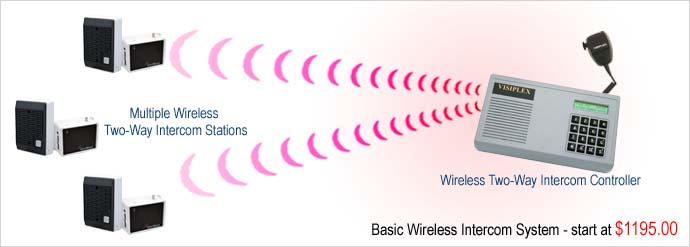

Non-radio "wireless" intercom designs were developed that used a building's existing electrical wiring to carry communication signals. The installation was typically done during the building’s construction, but buildings could be retrofitted with communication wires, at a cost. The first intercom systems communicated over a set of low-voltage signal wires installed in the walls of a building. Systems that use existing electrical cabling Ideally, the best intercom for an application would be one that is in a frequency not in use in the surrounding area, or one that uses digital spread spectrum to reduce possibility of interference. For instance, if a residence is using wireless networking which operates in the 2.4 GHz range, a wireless intercom that operates in this range may interfere with the network and vice versa. The frequency that will work best for an application depends on the wireless devices already in use not only in the building itself, but also in surrounding buildings. The United States and Canada have several frequency ranges for wireless intercom systems and other wireless products. Ess sounds like eff, requiring additional spoken clarification such as saying "'S' as in 'Sam'". Audio frequency response of current products is limited to less than 4 kHz this means that natural vocal sibilances above 4 kHz are absent.

The first use of encrypted wireless intercom in American football was in 1996 by 1999 it was being used in the Super Bowl. Telex, HME, Altair and other intercom manufacturers offer encrypted wireless intercom for corporate, military and sports team customers desiring instant voice communications with privacy. Wireless intercom privacy can be provided if the audio stream is encrypted. Most units on the market will allow intercom conversations to be heard through other devices such as scanners, baby monitors, cordless telephones, or the same brand of wireless intercom. Wireless intercom is not inherently private conversations on a wireless intercom are broadcast using publicly available wireless frequencies which means other users with similar devices could listen in if they are within range. Wired intercom is inherently private, so long as the wiring system isn't tapped by outside parties. Some wireless intercom designs reduce this interference by using " digital spread spectrum".

Radio frequency wireless systems may get interference from other wireless devices. One of the challenges of a wireless system is the possibility of interference. With battery-powered radio frequency wireless intercom units, a person can carry a station as they walk around. Another reason is the increased portability of a wireless system.

One reason to use a wireless intercom system is that the cost of retrofitting a building for a wired intercom system is high.


 0 kommentar(er)
0 kommentar(er)
